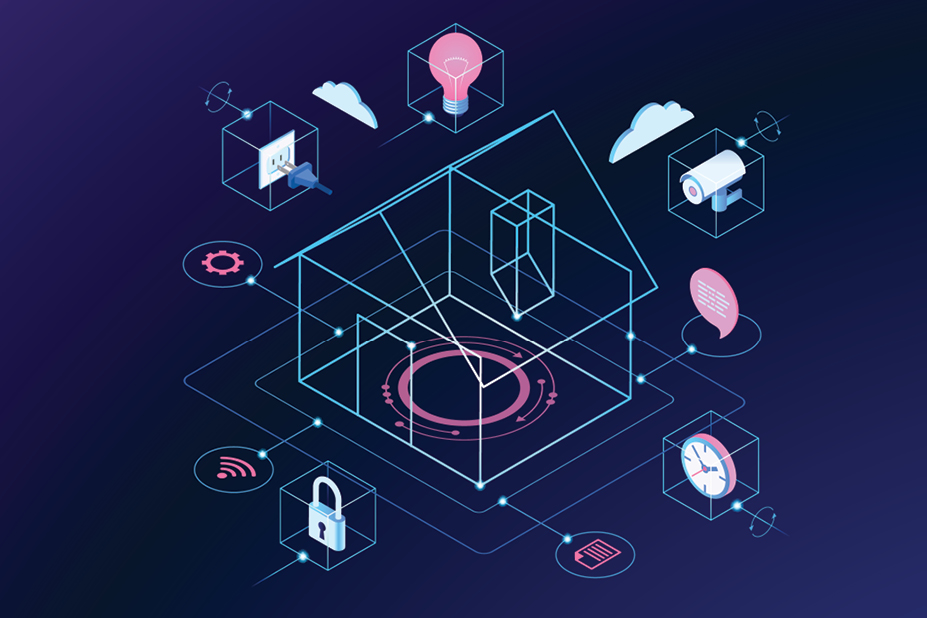To commemorate National Electrical Safety Month each May, the Electrical Safety Foundation International (ESFI) spearheads an annual campaign to educate key audiences about the steps they can take to reduce the number of electrically-related fires, fatalities, injuries, and property losses. ESFI’s 2020 theme, Smart Home, focuses on the lifesaving devices that keep a home smart and secure. Having a smart home doesn’t mean purchasing a new home, it means having the right equipment to keep families safe. ESFI’s National Electrical Safety Month program features resources to help facilitate effective electrical safety awareness for your home or workplace.
A smart home isn’t just about the automation and implementation of home security cameras, automatic lighting, wireless speakers, and smart thermostats. It’s about the lifesaving safety devices that provide peace of mind while at home and away.
The average American home is around 40 years old and does not have an adequate electrical system to meet today’s demands. ESFI is educating consumers on the devices that can meet their home’s electrical needs: ground-fault circuit interrupters (GFCIs), surge protective devices (SPDs), arc-fault circuit interrupters (AFCIs), and tamper resistant receptacles (TRRs). These devices are all required in new or renovated homes according to the National Electrical Code.
Before a consumer plans a renovation or home upgrade, ESFI urges them to consult a qualified electrician to complete all electrical work. IEC members are qualified electricians who have four to five years of on the job training, are up to date on their state’s electrical code, and are licensed, insured, and bonded in their state. They purchase from reputable retailers and distributors, stand behind their work, and can be reached by multiple methods. They perform safe work, leave a paper trail, pull required permits, and provide the most energy efficient solutions. In addition to emphasizing the importance of consulting qualified electricians, ESFI provides information on what safety devices should be installed and how they operate. Contractors can share this material with their customers to help them make safe and informed decisions.
GFCIs
Since the 1970s, GFCIs have saved thousands of lives and have helped cut the number of home electrocutions in half. GFCIs trip electrical circuits when they detect ground faults or leakage currents. A person who becomes part of a path for leakage current will be severely shocked or electrocuted. These outlets prevent deadly shock by quickly shutting off power to the circuit if the electricity flowing into the circuit differs by even a slight amount from that returning. A GFCI should be used in any indoor or outdoor area where water may come into contact with electrical products. The 2020 National Electrical Code currently requires that GFCIs be used in all kitchens, bathrooms, garages, outdoor areas, laundry areas, and in all 125-volt through 250-volt receptacles supplied by single-phase branch circuits rated 150-volts or less to ground in eleven locations of a dwelling. Dryer and range receptacles, common 250-volt receptacles in homes, require GFCI protection.
Power Surges
A power surge is a sudden and unwanted increase in voltage that can damage, degrade, or destroy electronic equipment. Surges can be caused by internal sources, such as when large appliances turn on and off, or external sources such as lightning. The average home has $15,000 worth of equipment that can be damaged by a surge, but SPDs can prevent this damage. SPDs are installed inside or outside the home to protect lighting, ovens, refrigerators, water heaters, washers, dryers, heating, air conditioning, entertainment systems, and more. In a commercial setting, SPDs protect lighting circuits, metering, medical equipment, critical loads, backup power, uninterruptable power supply, and HVAC equipment. In an industrial setting they protect power distribution, control cabinets, programmable logic controllers, electronic motor controllers, and equipment monitoring.
Home Fires
Home fires are more deadly and costly than ever. While the number of total fires and fire injuries are decreasing, property damage and fire deaths are on the rise. Each year arc-faults start more than 35,000 home fires causing over 1,130 injuries, 500 deaths, and $1.4 billion in property damage. Arc-faults occur because of damaged electrical wiring and insulation, overheated or damaged extension cords under carpets or rugs, and damaged or loose connections. AFCIs are required in bedrooms, closets, kitchens, laundry areas, living rooms, family rooms, rec rooms, parlors, libraries, and dens. Types of arc-fault protection include listed combination-type AFCI circuit breakers, listed outlet branch-circuit type AFCI receptacles, and listed outlet branch-circuit type AFCI receptacles in combination with a listed branch-circuit overcurrent device.
Electric Shock
Each year, approximately 2,400 children suffer severe shock and burns when they stick items into the slots of electrical receptacles. That is nearly seven children per day. It is estimated these actions cause around six to 12 fatalities per year. Nearly one-third of these injuries are the result of small children placing ordinary household objects, such as keys, pins, or paperclips into the outlets with disastrous consequences. Located in practically every room in all homes throughout the United States, electrical outlets and receptacles represent a constant and real danger wherever young children are found. TRRs prevent these injuries and fatalities from happening in the first place. They are required in new and renovated childcare facilities, hotel and motel guest rooms, preschools and elementary education facilities, gyms, skating rinks, auditoriums, and places of waiting. They are also required in offices, corridors, waiting rooms, and similar rooms in clinics, medical and dental offices, and outpatient facilities.
Awareness & Education
Electrical safety awareness and education among consumers, families, employees, and communities will prevent electrical fires, injuries, and fatalities. ESFI strongly encourages states and jurisdictions to adopt the most recent codes and standards to protect residents with the latest advancements in safety technology. To help promote each year’s campaign, ESFI reaches out to state governors to urge them to proclaim May as National Electrical Safety Month. States that have made proclamations for 2020 include Alabama and South Dakota. For ESFI’s complete collection of free resources and information on using them in your community, visit www.esfi.org. ESFI is continually focused and dedicated to reducing the number of electrically related injuries and fatalities in the home and in the workplace.




